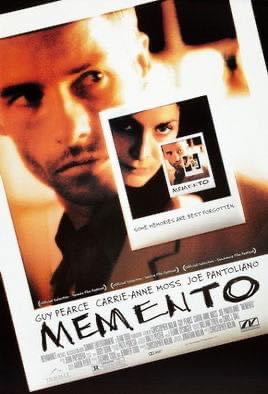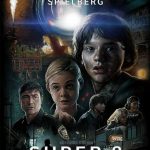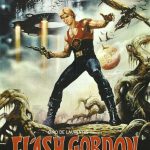Memento (2000)

Directed by: Christopher Nolan
Written by: Christopher Nolan (based on a short story by Jonathan Nolan)
Starring: Guy Pearce, Carrie-Anne Moss, Joe Pantoliano
Plot Summary:
“Memento” tells the story of Leonard Shelby (Guy Pearce), a man suffering from anterograde amnesia, a condition that prevents him from forming new memories after a traumatic incident—the rape and murder of his wife. Leonard’s life revolves around a mission of vengeance as he attempts to find her killer, all while using photographs, notes, and tattoos to piece together clues in a world where he can’t remember anything beyond a few minutes.
What sets “Memento” apart from other thrillers is its non-linear structure. The narrative is divided into two parts: one unfolds chronologically forward (in black and white), and the other is shown in reverse order (in color), eventually meeting at a crucial point in the film. This structure mirrors Leonard’s mental state, making the audience experience his confusion and fragmented reality.
Suggested videos for you:
Direction and Writing:
Christopher Nolan’s direction in “Memento” is both daring and innovative, offering a jigsaw puzzle of a narrative that keeps audiences constantly on edge. The film’s non-linear timeline challenges viewers to stay mentally engaged as they try to make sense of Leonard’s world. Nolan manages to convey the complexities of memory and perception through both the fractured storyline and Leonard’s unreliable narration.
The screenplay, adapted from Jonathan Nolan’s short story Memento Mori, is rich with philosophical questions about identity, self-deception, and the nature of truth. The film doesn’t offer easy answers but instead revels in ambiguity, as Leonard’s pursuit of justice raises doubts about whether he is truly the hero or a self-deluded antihero. As viewers come to understand more about Leonard’s condition, they are forced to question their own reliance on memory and trust .
.
Themes and Symbolism:
One of the central themes of “Memento” is the unreliable nature of memory. Leonard’s amnesia becomes a metaphor for the human tendency to alter, suppress, or reinvent memories. This makes the film more than just a revenge thriller—it’s a psychological exploration of how memories shape our identity and morality. The tattoos on Leonard’s body, which he uses to remember key facts, symbolize the fragility of truth and the desperate human need to construct meaning from chaos.
There is also a recurring theme of self-deception. Leonard claims he is committed to truth and justice, but as the film progresses, it becomes clear that he may be willingly blinding himself to painful realities. His quest for vengeance turns out to be built on shaky foundations, and his inability to move beyond his wife’s death becomes a self-imposed prison.
Performance:
Guy Pearce delivers a masterful performance as Leonard Shelby. He captures the character’s desperation and vulnerability while also exuding a cold determination that borders on psychopathy. Pearce’s portrayal is crucial because, despite Leonard’s condition, he remains a character audiences can both empathize with and distrust. His amnesia makes him unpredictable, and Pearce plays into this ambiguity skillfully, leaving audiences unsure whether Leonard is a tragic victim or the architect of his own misery.
Carrie-Anne Moss, as Natalie, and Joe Pantoliano, as Teddy, provide strong supporting performances. Both characters blur the line between friend and foe, complicating Leonard’s quest and adding layers of manipulation to the story. Their performances help build the tension as Leonard’s world becomes increasingly tangled with lies and half-truths.
Cinematography and Editing:
Wally Pfister’s cinematography and Dody Dorn’s editing work in tandem to make the film’s complex narrative structure feel cohesive and engaging. The contrast between the black-and-white and color sequences is not just a stylistic choice but a vital storytelling tool. The cinematography is often claustrophobic, emphasizing Leonard’s mental and emotional imprisonment. Close-up shots of his tattoos and his constant note-taking serve as visual reminders of his fractured sense of reality.
The editing is perhaps the film’s most remarkable technical achievement. The reverse-order scenes could have easily been confusing or frustrating, but the pacing and transitions are handled so deftly that they build suspense instead. The audience, much like Leonard, is always working backward to uncover the truth, which makes the reveals more impactful.
Reception and Legacy:
“Memento” was a breakthrough for Christopher Nolan, cementing his reputation as a filmmaker willing to push the boundaries of narrative structure and explore complex psychological themes. The film was praised for its originality, with many critics lauding its intricate plot and compelling performances. Guy Pearce’s portrayal of Leonard was particularly singled out for its depth and emotional range.
The film received numerous accolades, including Academy Award nominations for Best Original Screenplay and Best Editing. Over time, “Memento” has become a cult classic, frequently cited in discussions of mind-bending cinema and non-linear storytelling. Its influence can be seen in many films and TV shows that play with narrative structure and unreliable narrators
Conclusion:
“Memento” is an intellectual thriller that transcends its revenge-driven plot, diving deep into philosophical questions about memory, identity, and the search for truth. Its intricate structure, strong performances, and psychological depth make it a film that rewards multiple viewings. It’s a landmark film in Christopher Nolan’s career and a touchstone in modern cinema for its innovative approach to narrative storytelling.
For those willing to engage with its complex structure and unsettling themes, “Memento” offers a cinematic experience that lingers long after the credits roll, much like the lingering fragments of Leonard’s shattered memory.











